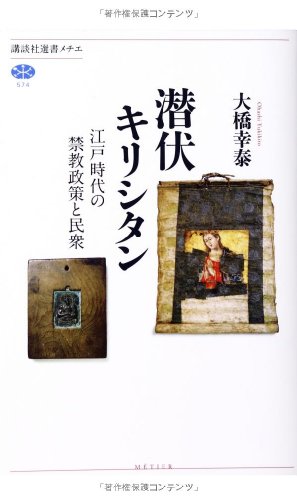10 0 0 0 OA 幕末期における異端的宗教活動の摘発 -対馬藩田代領「新後生」の場合-
- 著者
- 大橋 幸泰
- 出版者
- 早稲田大学教育・総合科学学術院教育会
- 雑誌
- 学術研究 : 人文科学・社会科学編 (ISSN:21866996)
- 巻号頁・発行日
- vol.63, pp.三五-四九, 2015-03-25
- 著者
- 大橋 幸泰
- 出版者
- 国文学研究資料館
- 雑誌
- 国文学研究資料館紀要 = The Bulletin of National Institure of Japanese Literature Archival Studies (ISSN:18802249)
- 巻号頁・発行日
- no.12, pp.123-134, 2016-03-14
本稿では、日本へキリシタンが伝来した16世紀中期から、キリスト教の再布教が行われた19世紀中期までを対象に、日本におけるキリシタンの受容・禁制・潜伏の過程を概観する。そのうえで、どのようにしたら異文化の共生は可能か、という問いについて考えるためのヒントを得たい。キリシタンをめぐる当時の日本の動向は、異文化交流の一つと見ることができるから、異文化共生の条件について考える恰好の材料となるであろう。 16世紀中期に日本に伝来したキリシタンは、当時の日本人に幅広く受容されたが、既存秩序を維持しようとする勢力から反発も受けた。キリシタンは、戦国時代を統一した豊臣秀吉・徳川家康が目指す国家秩序とは相容れないものとみなされ、徹底的に排除された。そして、17世紀中後期までにキリシタン禁制を維持するための諸制度が整備されるとともに、江戸時代の宗教秩序が形成されていった。こうして成立した宗教秩序はもちろん、江戸時代の人びとの宗教活動を制約するものであったが、そうした秩序に制約されながらも、潜伏キリシタンは19世紀中期まで存続することができた。その制約された状況のなかでキリシタンを含む諸宗教は共生していたといえる。ただし、それには条件が必要であった。その条件とは、表向き諸宗教の境界の曖昧性が保たれていたことと、人びとの共通の属性が優先されたことである。This paper is an overview of the process of the acceptance, prohibition, and concealment of Christianity in Japan from the time it was first introduced in the mid-16th century until its re-introduction in the mid-19th century. In doing so, it is my hope that we can find some lessons for making the co-existence of different cultures possible. Happenings relating to Christianity in Japan at the time can be seen as a form of cultural exchange, and therefore will surely provide suitable material for considering the conditions for cultural coexistence.While the Christianity transmitted in the mid-16th century was widely accepted by Japanese at the time, it also was resisted by the forces that sought to maintain the existing order. Toyotomi Hideyoshi and Tokugawa Ieyasu, who brought about unification after the Sengoku period, considered Christianity to be incompatible with the national order they sought, and they attempted to thoroughly eliminate it. Then, as various systems were developed to maintain the prohibition of Christianity through the latter 17th century, the religious order of the Edo period was formed. While this religious order was, of course, intended to restrict the religious activities of the people of the Edo period, hidden Christians were able to continue to exist up to the mid-19th century, even under its constraints. It could be said that various religions, including Christianity, coexisted under these constrained circumstances. However, there were necessary conditions for this, namely, the ambiguity of the boundaries between religions being preserved on the surface, and the attributes people share in common being prioritized.
6 0 0 0 OA 正統・異端・切支丹 : 近世日本の秩序維持とキリシタン禁制(上)
- 著者
- 大橋 幸泰
- 出版者
- 早稲田大学教育学部
- 雑誌
- 學術研究. 地理学・歴史学・社会科学編 = Gakujutsu kenkyu. Geography・history・social science (ISSN:09130179)
- 巻号頁・発行日
- vol.54, pp.11-26, 2006-02-25
- 著者
- 大橋 幸泰
- 出版者
- 国文学研究資料館
- 雑誌
- 国文学研究資料館紀要. アーカイブズ研究篇 = The bulletin of the National Institute of Japanese Literature. 人間文化研究機構国文学研究資料館 編 (ISSN:18802249)
- 巻号頁・発行日
- no.12, pp.123-134, 2016-03
本稿では、日本へキリシタンが伝来した16世紀中期から、キリスト教の再布教が行われた19世紀中期までを対象に、日本におけるキリシタンの受容・禁制・潜伏の過程を概観する。そのうえで、どのようにしたら異文化の共生は可能か、という問いについて考えるためのヒントを得たい。キリシタンをめぐる当時の日本の動向は、異文化交流の一つと見ることができるから、異文化共生の条件について考える恰好の材料となるであろう。 16世紀中期に日本に伝来したキリシタンは、当時の日本人に幅広く受容されたが、既存秩序を維持しようとする勢力から反発も受けた。キリシタンは、戦国時代を統一した豊臣秀吉・徳川家康が目指す国家秩序とは相容れないものとみなされ、徹底的に排除された。そして、17世紀中後期までにキリシタン禁制を維持するための諸制度が整備されるとともに、江戸時代の宗教秩序が形成されていった。こうして成立した宗教秩序はもちろん、江戸時代の人びとの宗教活動を制約するものであったが、そうした秩序に制約されながらも、潜伏キリシタンは19世紀中期まで存続することができた。その制約された状況のなかでキリシタンを含む諸宗教は共生していたといえる。ただし、それには条件が必要であった。その条件とは、表向き諸宗教の境界の曖昧性が保たれていたことと、人びとの共通の属性が優先されたことである。This paper is an overview of the process of the acceptance, prohibition, and concealment of Christianity in Japan from the time it was first introduced in the mid-16th century until its re-introduction in the mid-19th century. In doing so, it is my hope that we can find some lessons for making the co-existence of different cultures possible. Happenings relating to Christianity in Japan at the time can be seen as a form of cultural exchange, and therefore will surely provide suitable material for considering the conditions for cultural coexistence.While the Christianity transmitted in the mid-16th century was widely accepted by Japanese at the time, it also was resisted by the forces that sought to maintain the existing order. Toyotomi Hideyoshi and Tokugawa Ieyasu, who brought about unification after the Sengoku period, considered Christianity to be incompatible with the national order they sought, and they attempted to thoroughly eliminate it. Then, as various systems were developed to maintain the prohibition of Christianity through the latter 17th century, the religious order of the Edo period was formed. While this religious order was, of course, intended to restrict the religious activities of the people of the Edo period, hidden Christians were able to continue to exist up to the mid-19th century, even under its constraints. It could be said that various religions, including Christianity, coexisted under these constrained circumstances. However, there were necessary conditions for this, namely, the ambiguity of the boundaries between religions being preserved on the surface, and the attributes people share in common being prioritized.
2 0 0 0 OA 近世日本潜伏キリシタンの信仰共同体と生活共同体
- 著者
- 大橋 幸泰
- 出版者
- 早稲田大学地中海研究所
- 雑誌
- 地中海研究所紀要 (ISSN:13482076)
- 巻号頁・発行日
- vol.4, pp.111-117, 2006-03-01
1 0 0 0 近世日本のキリシタンと異文化交流
2019年度も前年度に引き続き、世界各地に散在しているキリシタン関係史料の調査を進め、科研メンバーの研究課題に有益な成果が得られた。ポルトガルのアジュダ図書館・エヴォラ公共図書館における調査では、キリシタンが殉教者として認定されるために必要とされた情報・証言の史料や、イエズス会日本管区代表プロクラドールの関係史料を見いだした。スペインの王立アカデミー図書館における調査では、「鎖国」へ向かう時期の日本の殉教報告、教皇への書翰の作成に関する史料、ヨーロッパで日本布教をめぐる主導権争いの史料などを発見した。国内では、国立公文書館のほか、高知・長崎・大分・天草などで調査を行い、キリシタン禁制関係の史料を採集した。これにより、キリシタン禁制政策を維持する宗門改・類族改の実情を明らかにできる。ただし、年が明け新型コロナウイルス感染拡大の影響により、2020年3月の調査が不可能になった。そのため、一部の予算を2020年度に繰り越し、調査予定を繰り延べた。一方、2019年度で特筆するべき点は、6月22日にシンポジウム「近世東アジアにおけるキリシタンの受容と弾圧」を早稲田大学で開催したことである。清水有子「日本におけるキリシタン禁令の成立過程―正親町天皇の永禄8年京都追放令を中心に―」、マルタン・ノゲラ・ラモス「失われたキリシタン民衆の声を求めて―島原天草一揆後の排耶書を中心に―」、ピエール・エマニュエル・ルー「日本から中国までの禁教―清代の絵踏を中心に―」、牧野元紀「近世ベトナムにおけるキリシタンの受容と弾圧」の4本の報告と、三野行徳「支配・統治の仕組みとしてのキリシタン禁制・弾圧を考える」の1本のコメントを用意し、近世東アジアのキリシタンをめぐる対応について、共通点・差異点を議論した。50人以上の参加者を得て、有意義な討論ができたと思う。
- 著者
- 大橋 幸泰
- 出版者
- 歴史科学協議会
- 雑誌
- 歴史評論 = Historical journal (ISSN:03868907)
- 巻号頁・発行日
- no.832, pp.102-106, 2019-08
1 0 0 0 書評 芹口真結子著『近世仏教の教説と教化』
- 著者
- 大橋 幸泰
- 出版者
- 日本史攷究会
- 雑誌
- 日本史攷究 (ISSN:1883325X)
- 巻号頁・発行日
- no.43, pp.116-121, 2019-12
1 0 0 0 潜伏キリシタン : 江戸時代の禁教政策と民衆
- 著者
- 大橋 幸泰
- 出版者
- 青木書店
- 雑誌
- 歴史学研究 = The journal of historical studies (ISSN:03869237)
- 巻号頁・発行日
- no.941, pp.13-21, 2016-02
